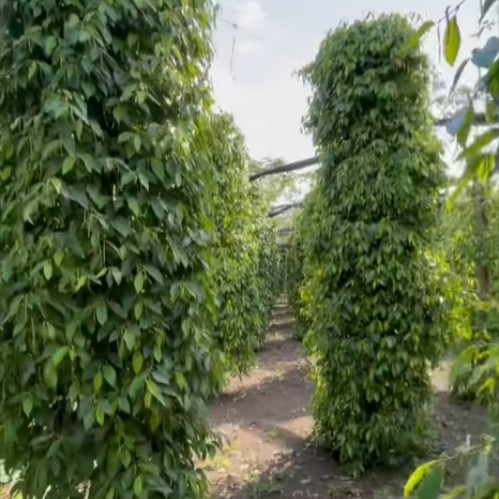
Vanilla


- Vacuum sealed with food grade plastic
- Grade A, B & C
- Different sizes and packaging
Get ready for an exhilarating experience when you open a pouch of Papua Indonesian vanilla beans. The moment you take a whiff, your senses will be overwhelmed by the intense, earthy aroma of pure vanilla. Hold one close to your nose, and you'll be enticed by hints of dark chocolate and a smoky essence reminiscent of fine bourbon.
Papua Indonesian vanilla beans are known for their abundant oiliness and bold fragrance. Ranging from 5” to 7” inches in length, these beans boast a deep, luscious dark brown hue. Dark chocolate enthusiasts can't get enough of them, as they make the perfect addition to your desserts.
Prima DG vanilla beans are all shipped vacuum sealed for freshness and should be stored unrefrigerated in a cool, dry and dark place.



Indonesia's tropical climate, with its high moisture levels, nurtures the fertile growth of the Planifolia vanilla plant, known as Madagascar Bourbon. Renowned for its exceptional productivity, this variant thrives in the Indonesian setting. Vanilla Planifolia, the predominant species, boasts a robust and delightful fragrance, reminiscent of richness, creaminess, sweetness, and even a hint of hay. The beans themselves are distinguished by their thick skin and longer size compared to Tahitian vanilla beans. Moreover, they are generously packed with an abundance of flavorful seeds, setting them apart from their Tahitian counterparts.
Below you can find a list of the most important characteristic:
| Name | Vanilla Planifolia |
| Grade | A Gourmet |
| Ingredients | 2.2% - 2.8% vanilin |
| Length | 17 cm up |
| Moisture content | 30% - 35% |
| Flavour | smooth, creamy and rich |
| Use for | baked goods, chocolate, cream dessert, beverages |
| Details | Gourmet, no split |
| Country of origin | Indonesia |
| Packages | vacuum packed using food grade plastic |
From Papua, usually the beans are shorter and plumper than vanilla planifolia one. Its aroma is delicate with floral and fruit notes. Due to this characteristic is favored by pastry chef, and in general it is prized by European gourmet professional.
| Name | Vanilla Tahitensis |
| Grade | A Gourmet |
| Ingredients | 1.5% - 2.1% vanilin |
| Length | 13 - 17 cm |
| Moisture content | 25% - 35% |
| Flavour | cherries, delicate, fruity, sweet |
| Use for | cream dessert, savory sauces, pastry and beverages |
| Details | Gourmet, no split |
| Country of origin | PAPUA |
| Packages | vacuum packed using food grade plastic |
Coffee


- Arabica & Robusta
- Grade 2
- Green beans
This type of coffee is distinguished by its full body, distinct herbal tones, and with a low acidity. This low acidity makes it particularly attractive for people who have a sensitivity to the otherwise healthy organic acids in coffee.
Sumatran coffee farmers don’t use chemicals, which slows down the harvesting process, but ensures only mature beans are collected. Immature coffee beans have less dynamic flavor and tend to make a bitter coffee. But the real secret sauce to Sumatra coffee is how the farmers process the beans after they’re harvested, and in turn, how an artisan roaster decides to small-batch roast the beans, which brings out the flavors the Giling Basah process added to the coffee.



Ever since its introduction in the 1970s, coffee production in Sumatra has embraced a distinctive method known as wet-hulling, or Giling Basah. This process involves swiftly removing the hull from freshly harvested coffee fruits while they retain their moisture, hence the term "wet." Subsequently, the beans are placed in a sealed bag overnight, allowing a gentle fermentation to take place. The following day, they are spread out to dry for a few hours, either on raised screen beds or in the coffee farmers' own backyards. Once the coffee reaches an ideal moisture level of around 14%, it is procured by importers/exporters and packed in jute sacks for shipment to its final destination.
The wet-hulling method predominates in Sumatra due to the region's volatile tropical climate, which grants farmers limited time—typically four hours or less per day—to dry the coffee. As a result, the beans retain approximately five times the moisture content of water-processed and sun-dried coffee. This unique Giling Basah process yields a coffee with a remarkably low acidity and a distinct earthy profile, some even describing it as having a subtle mushroom-like flavor. The aroma of Sumatra coffee exudes a captivating woodland vibe, with a hint of umami in its lingering finish, which undoubtedly contributes to the adoration of coffee enthusiasts who favor Sumatran beans.
Pepper


- Vacuum sealed with food grade plastic
- 550 GL & 580 GL
- Customizible packaging
Black pepper.
The most traded spice in the world, black pepper is the dried fruit of the pepper plant and is used to flavor a variety of applications. The unripe berries of the pepper plant are picked when turning yellow and immediately dried after harvest with the skin on. As it dries, enzymes in the berries cause the skin to turn black and wrinkly.
White pepper.
A milder form of pepper, with a lightly fermented aroma and taste, white pepper is grown on the same vine as black pepper. However, white pepper differs because it is made from peppercorns that are picked ripe and processed to remove the outer skin, leaving behind a smooth white finish on the berry. White pepper tastes bright and sharp and slightly more herbaceous than black pepper.



something